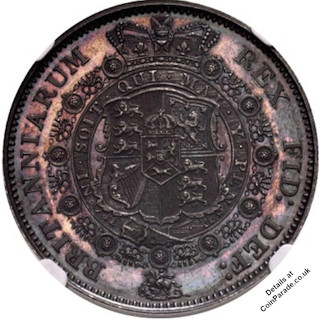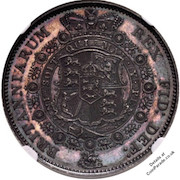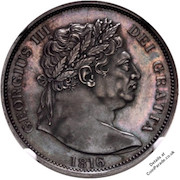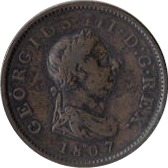
 The 1816 Half-Crown Proof George III
The 1816 Half-Crown Proof George IIIGeorge III Silver Proof Half-Crown dated 1816. London Mint. Diameter 32mm, weight 14.31g. SCBC 3788. Graded PF 63 with attractive deep purple toning.
This is the plain edge proof which is rarer than the non-plain edge.
Reverse is Crowned and collared coat-of-arms.
 Obverse is George III Laureate bust (bull head) right.
Obverse is George III Laureate bust (bull head) right.Images used by permission of CNGCoins. Photographed in NGC encapsulation.
Mintage: Not known
Minted at The Royal Mint
More information (monarch, year, mint, country, category) can be found below coin listings.
Below are some coins currently being offered on eBay. As an eBay Partner, We may be compensated if you make a purchase.
List items on:
List items on:
Remember 1816 ?
George III is King but due to illness his son George is Prince Regent. Prime Minister is Robert Jenkinson, 2nd Earl of Liverpool (Tory). US President is James Madison (DR-Virginia). Sir Humphry Davy's lamp is first tested. The Coinage Act and Great Recoinage attempt to stabilise the currency by reintroduction of silver coinage for transactions under forty shillings and changing the gold coinage from the guinea valued at 21 shillings to the slightly lighter gold sovereign worth 20 shillings and defining the value of the pound sterling relative to gold.
George III (1760-1820)
 Born on 4 June 1738 to Frederick, Prince of Wales and Augusta of Saxe-Gotha in the house of Hanover, George III reigned for over 59 years.
Born on 4 June 1738 to Frederick, Prince of Wales and Augusta of Saxe-Gotha in the house of Hanover, George III reigned for over 59 years.George had 15 children - nine sons and six daughters. In the latter part of his life George suffered from a mental illness and his son George became Prince Regent from 1811-1820 and ruled on his behalf. On George III's death, the Prince Regent became George IV.
Note the latin spelling of George on his coins: Georgivs.
Category: Half-Crowns
The half crown was a British coin which was valued at "2/6" (two shilling and sixpence) – 12½ pence in modern currency. It was literally half the value of the Crown.Half crowns were first issued around 1549 in gold or silver. It was then issued by the majority of Monarchs (plus Oliver Cromwell) all the way through to Elizabeth II. The last standard mintage was in 1967 and the coin was officially demonetised in 1970, one year before full decimalisation. A proof half crown was released in 1970.
The halfcrown was a large coin, from 1816 to it’s final minting having a diameter of 32mm and weight of 14.1g. In pre-decimalised Britain when the Crown was essentially a commemorative coin, the half crown was the largest denomination coin in circulation and had considerable spending power.
Before 1920, half crowns were actual sterling (92.5%) silver. This was reduced to 50% silver and in 1947 no silver at all was used and cupro-nickel became standard.
Half crowns are beautiful coins to collect and due to their long history they are very popular. As pre-1920 coins are 92.5% silver even worn copies will have the intrinsic price of the metal but they are still very affordable to most people.
Which Mint: The Royal Mint
The Royal Mint is the designated place for the UK to mint coins. It dates back well over 1000 years and is a Government-owned company. Formed in the reign of Alfred the Great about the year 886, during the period 1279-1812 it was generally referred to as The Tower Mint as it was housed at the Tower of London. The Master of The Royal Mint has included famous figures such as Sir Isaac Newton.
Since 2010 it has operated as Royal Mint Ltd, a company owned by HM Treasury, under an exclusive contract to supply all coinage for the UK although it also produces medals and coins for other countries. It is currently located at Llantrisant, Wales.
Country of Origin: United Kingdom
The United Kingdom (UK) is the Union of England, Scotland, Wales and Northern Ireland. It is often refered to as Great Britain (GBR). It has a long, rich history. The orignal coinage was Pounds, Shillings and Pence but since decimalisation on 15 February 1971, it is £1 = 100p, that is One Pound = 100 pence. The coinage of the UK is also a long history, the Royal Mint being established as long ago as 886AD when coins were hammered. Today there is perhaps 30 billion coins in circulation, and many (numismatic) collectors coins and sets are issued frequently in gold, silver and other metals.
Try the Half-Crowns page on eBay UK
As an eBay Partner, We may be compensated if you make a purchase.
As an eBay Partner, We may be compensated if you make a purchase.







